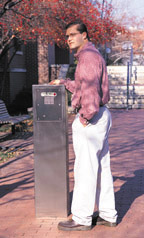
Add to this the requirements of the Americans with Disabilities Act (ADA), which adds the concept of "accessibility" to the facilities planner's and security professional's responsibilities.
Easily identified, available, accessible communications systems can go a long way in providing the assistance that is necessary. A brief look at the actions of campuses around the country can show how these problems can be effectively and economically addressed.
Parking facilities always have their own challenges, and those on college campuses add some of their own as well. The main challenges in a parking facility are to address two, somewhat different situations.
First, there is the "emergency" issue, whether a strict security problem or a medical emergency taking place, within the parking facility. How does the person in the garage quickly obtain outside help, (which may well be off-site) and can they generate a local, visual signal so that anyone else in the facility will know that assistance is needed. The added benefit of the visual signal is that if the problem is a robbery or assault, the perpetrator may well run away, ending the attack, seeing that attention is being drawn to the location.
The second problem is less of an emergency than one of service to someone with a problem. And the resource to be called may well be other than campus security. For example, someone parking in the facility may return to their car to find a dead battery, flat tire or other problem. In addition, a visitor to the campus may find that although they were certain they knew where they put their car that morning they can no longer find it that night in the multi-story, double helix deck. That visitor, who could be a parent or trustee of the university, is in need of, and might well be very appreciative of, some friendly assistance.
A Plan of Action
De Paul University in Chicago has its main campus located in the scenic Lincoln Park area on the north side of the city. The University's thirty-five buildings are spread out over a thirty-one acres, which combine not only university buildings but commercial and residential properties, as well. The student population out and about at all hours, not only on school-related activities, but enjoying this exciting part of the city.Robert Wachowski, University Security Director, has been making a major effort to provide the availability of emergency assistance to students, staff and visitors should that need arise.
These efforts were focused on two aspects of university life in particular. The first concern was to provide access to emergency communications along the open paths on the large urban campus. The second focus was the increasing number of parking facilities that the university maintains on campus.
Wachowski wanted a reliable, visible and user-friendly system. With management approval, he began working with a security consultant, who suggested the Talk-A-Phone emergency phone system manufactured by Talk-A-Phone Co., Chicago. He also visited other facilities that were using Talk-A-Phone units, including a hospital and an airport. These facilities stated that they functioned well in their applications.
In the first phase, the university installed eighteen of the units throughout the campus, mounted on Talk-A-Phone's 9 1/2 ft. tall tower, with a blue light/strobe on top, on in their stainless steel wall mounts with integrated blue light/strobe, mounted to the side of buildings. The continuously glowing blue light calls attention to the location of the unit.
The units have been placed primarily in dark, isolated spots. For example, one unit is installed near a small mass transit station located between a residence hall and a campus building.
The phones are easy to use. Simply pushing the "Emergency" button once starts a call to the security office and simultaneously turns on the bright flashing strobe, calling immediate attention to the location.
Like other larger users, De Paul is using Talk-A-Phone's Talk-A-Lert software, which automatically generates a report on the computer screen as soon as the officer answers the incoming emergency call. This screen shows the location of the call and other information, logs the event in the system and provides the ability for the dispatching officer to enter log comments about this particular event.
This enables the dispatcher to send the correct assistance to the correct location. The ability to speak to the location, as well as hear what is going on, is also valuable.
The second phase was to install Talk-A-Phone Emergency Phones in the ever-increasing number of parking decks that De Paul is constructing on campus. In order to conserve phone lines on their PBX, the units in the parking facilities are connected to the PBX through Talk-A-Phone 8-channel mutiplexer. Even using these line-savers, when the call comes in from an Emergency Phone, the location identification feature of Talk-A-Lert identifies the actual location of the emergency phone that is calling.
Parking lots and decks have special needs as users are often entering or leaving at odd hours, when there may not be many others around. The need for quick, easy communication is obvious. And automatically checking the reliability of this equipment, identifying where emergency calls are coming from, and time-logging all these events adds another element of value to the system. With Talk-A-Phone's complete line of ADA compliant, hands-free emergency phones and accessories, virtually every campus parking emergency communication need can easily be met.